Taiwan Makers Aim for More Efficient LED Lamp Packaging
2009/06/05 | By Ken LiuLED lamp manufacturers in Taiwan have been working hard to make brighter and longer lasting products, and on both measures they have certainly come a long way.
One of the main ingredients in achieving these gains has been more efficient thermal dissipation in LED packaging and thermal modules. An LED lamp converts only 15 to 20% of electrical input into light, turning the remainder into heat. If the heat is not effectively exhausted into the ambient air, the life and luminosity of the LED lamp will be compromised by excessive heat built-up inside the lighting device.
Over the past few years, Taiwanese LED manufacturers have worked out their own unique packaging solutions to improve the durability and luminosity of their LED lighting products.
Superior Substrate
One patented packaging technology developed by ProLight Opto Technology Corp is a dual-conductor copper substrate divided by a thermal-transfer strip. "The notable feature of this element is its uni-body copper structure, which eliminates the need of an additional heat-sink," company president Michael Hsing says. The ingenious structure is patented both in Taiwan and the United States. Typically heat-sink and electrodes are built on different pieces.
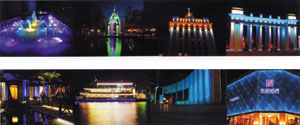

Soldering further helps boost conductivity of the company's LED package: ProLight solders LED chip's electrode pins to circuit boards, instead of using thermal conductive adhesive. "Solder's conductivity efficiency is 17-39 W/m.K while the adhesive's is only 0.3-3 W/m.K," Hsing notes. But the company adheres the chip to copper substrate with silver adhesive, which also accelerates the conductivity.
The unique substrate structure also enables the company to shrink its lamp package to just 2mm long-a feat that previously would have required the use of ceramic substrate, according to Hsing.
Thanks to efficient thermal-dissipation, the company's LED lamps deliver excellent luminosity durability: its one-watt package driven by 350mA was field tested at 91.06% brightness after 10,000 hours of non-stop operation.
ProLight also encapsulates LED chips with optic-grade silicone, which is considered technologically superior to the epoxy resin used widely in the industry. "Silicone is superior to epoxy in transparency and resilience, as well as heat and ultraviolet resistance," Hsing notes. The company field tested its typical high-power package at 80% of light output after 16,000 hours of non-stop operation, compared with a 5-mm epoxy white LED's 20% of output.
Recently, the company has improved the formula of its silicone encapsulate to make it more reliable in terms of thermal shock and soldering resistance.
ProLight offers 0.3W to 15W RGB, UV, yellow and white packages using chips ranging from 24 mil to 60 mil (0.6mm to 1.5mm) in size and sourced from various suppliers. Its monthly capacity is three million devices. Most of its packages go into portable, landscape and entertainment lighting under its eponymous ProLight brand. "We never accept OEM orders because they can reduce our value," Hsing stresses.
Since starting up his own firm, Hsing has always focused on developing in-house technologies. "So we began applying for patents on structure and electrical-circuit designs as well as illumination quality," Hsing notes. ProLight draws on outside designs as a reference in developing its own products, but always with care to avoid patent infringement. "We have unique technologies, and also benefit from shared know-how."
ProLight has introduced circuitry that keeps emitters on the same module mutual interference when one burns up. Also the company has won patents for its unique packaging process that evenly spreads phosphor powder over LED chips, enabling emitters to give off light of consistent wavelength. "Our phosphor powders do not infringe anyone's patent rights," Hsing assures. The company has also patented its static-resistance technology.
Backed by its broad LED capability, ProLight provides lighting manufacturers with total solutions. "That's our value. Usually, lighting manufacturers know little about optics, thermal and current-drive issues related to LED. So, we tap our know-how in the three areas to design lighting solutions to suit specific needs," he adds.
Chip Array Packaging
Intematix Technology Center (ITC) Corp., the LED-packaging business of the Fremont, U.S.-headquartered phosphor-technology powerhouse Intematix Corp., is reportedly the exclusive Taiwanese LED packager to win patents on an unorthodox methodology featuring chip array in serial or parallel arrangement on a ceramic board bearing at least two cavities for holding the chips. "This is the result of our philosophy of never operating as an alternative to incumbent packaging technologies," stresses Harik Su, ITC's R&D vice president.
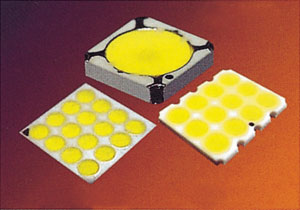
The Cetus family of packages is one of the company's main products. This type of packaging is made with ceramic-based chip-array packaging methodology and can be driven with DC or AC voltage, making the company one of the handful LED packagers to provide AC LED solutions. According to Su, Cetus employs a unique design to make each cavity connected on a LTCC ceramic substrate. The design, he says, allows ITC to create any desired array configuration to deliver an illumination profile with a pleasant, smooth and natural looking light. "These arrays really combine the features lighting companies are looking for including easy design, tight binning, robust thermal management and a simplified and scalable power and area design," he stresses.
The proprietary packaging methodology comes up with several advantages including RoHS compliance, zero moisture, and 90% illumination reflection rate. "Most of all," Su stresses, "production cost using this methodology is fairly low. Also, it offers a very convenient design environment since any new serial or parallel arrangement does not require changes to the lead frame layouts on the package. This helps our customers to quickly bring new products to market."
ITC uses the unique methodology mostly on LED packages under 10W, which Su thinks is currently a dominant power specification in the LED lighting market. "The power range above 0.5W and below 10W, we think, is the main product ranks now in the market. There won't be a huge market for products above 10W until at least 2010," he estimates. Accordingly, the company has used the methodology to primarily package low-power chips, which eliminating the need of any unnatural thermal-dissipation measure like adding fans to the thermal module.
Su emphasizes that his company never uses the packaging methodology on red-green-blue (RGB) chips encasing, which he says has lower patent barrier than does the pack comprising a blue chip wrapped with phosphor. The company's U.S. parent is said to be the world's leading phosphor-power manufacturer in terms of chromatic 'totality' for commercialized phosphor powder, offering one color every five nanometers on the spectrum.
Ceramic has satisfactory thermal conductivity, at 24-170 W/mK range, and a low coefficient of thermal expansion (CTE), at 4.9-8ppm/K rang, according to data complied by the government-backed Industrial Technology Research Institute (ITRI). Both factors add durability to the company's packages, which is marketed with a guarantee that illumination intensity will fall by only a single digit rate after 1,000 hours of operation.
The company's ceramic-based package provides thermal resistance to 8C/watt, and confines maximum anode-cathode junction temperature within 90C. "Our package delivers the best efficacy at 100lm/W and an optimized CRI at 93," Su reports.
The chip-array layout produces optimal light output with a cluster of dot lights on a fairly small ceramic piece, Su says. The company's 10W C1109 package, for instance, gives off a total of 800 lumens on an 11mm x 9mm board, reducing manufacturing cost.
Output capacity at the company is now 20 to 30 million packages a month. Most of the output is exported to the United States. According to Su, ITC will begin this year to expand sales in Europe to boost revenue. In Asia, Japanese manufacturers, he adds, are his company's prime buyers. "All of our products are for indoor applications," Su stresses.
The company's packaging technology frees its customers from patent lawsuits and its offer of total solution covering contract design, prototyping and tooling, lighting modules and OEM/ODM-based lighting systems backed up by its parent company saves customers a lot of trouble in dealing with the complexity of LED designs. Thanks to less risky products and convenient service, ITC's revenue for this year is projected to treble from last year, following a similar pace of growth last year, according to Su.
Chilling Out with Aluminum
As a thermal-module startup founded only one year ago, MicroSolar Corp. boasts an uncommon LED thermal-dissipation methodology-fixing an LED package using copper substrate directly on a five-inch aluminum wafer. "Sounds simple, right? Not necessarily," stresses company general manager Hayashi Wang. "Fixing a piece of copper to aluminum is not as easy as one might think. It takes some special technology, and we have the recipe to do it."
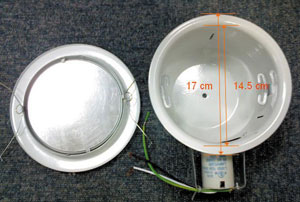
Due to strong thermal performance, the company's LED lamps put out more light than lamps using other thermal solutions, Wang says. "Our 6W lamps outdo Philips 12W lamps in terms of light output," he says. In support of this claim, he points to four beaming LED recessed Philips lamps in the company's showroom. He says his company's lamps each produce a total of 250 lumens.
Wang says his thermal methodology has been patented in the United States, Australia, Japan and Taiwan. "And we are talking with GE over licensing our technology to them," claims Wang.
Wang says his methodology is easy, inexpensive and simple. "First, aluminum is an inexpensive metal. Second, the disk is structurally simple. And it can easily be assembled with any type of lamp," he says. Although studies show that uneven surfaces dissipate heat quicker than flat surfaces due to the larger dissipation area, Wang dismisses the view and says that the fin-like structure commonly seen on many LED thermal modules is not efficient since the narrowness of the gap between fin leaf surfaces impedes heat dissipation.
"Also, a flat surface increases the light reflection ratio, boosting the illumination output of an LED lamp," he adds. The pride taken by the company in its disc design is evident from the glass screen at the company entrance, which reads "Light Emitting Disc (LED)," playing on the acronym for light emitting diodes.
The aluminum wafer module and package, Wang says, will eventually be available for just NT$100 (US$2.9) each. His company now ships 200,000 modules a month.
The company uses Taiwan-made packages with sapphire-based LED chips on the modules demonstrated at its showroom. However, Wang stresses that his company can use any type of LED chip on the modules depending on customer needs. The size of the aluminum disc can also be adjusted, he adds.
Evading the Patent Trap
Kaylu Industrial Corp. has introduced a unique LED package that frees it of reliance on outside patented technology. "Our products are protected by patents in the U.S. and Europe, so we can now export to those markets without fear of patent infringement," stresses Paul Chang, the company's sales representative.

Kaylu fixes chips on a pure-copper substrate with silver adhesive and plates the substrate with silver to protect it from tarnishing and help boost reflection of the light from LED. The substrate conducts heat at a staggering 398W/m.K rate.
The company's packaging is not only protected by its own patents but also by patents from its phosphor-powder and chip suppliers. "So, our customers need not to worry about using our products," Chang stresses.
Chang points out that LED package buyers are most concerned about the stability of color rendering, which is closely associated with thermal-conductivity and phosphor qualities.
Buyers have built the company's packages into MR16, recessed lamps, T8 lamps, garden lamps, flood lights, streetlights, road lights, and tunnel lights. "We are delivering one million packages a month to lighting manufacturers," Chang notes. His company supplies lighting manufacturers with not only LED packages but also custom-made lighting modules.
Kaylu has built up its LED packaging capability on its PCB-processing equipment business, which has been its main business since it was opened in 1987. "Designing electrical circuits on the boards is quite similar to package structure design. So, that's our advantage," Chang stresses. Another advantage is the company's competitive pricing. The company broke into the LED packaging segment in 2000 with a lead-frame design for Cu substrate, and it debuted its own LED packaging in 2007.
Although Chang believes the economic downturn has already taken a toll on LED lighting sales worldwide as the lamps are more expensive than most of the traditional lighting sources, he believes the market will improve as eco-energy issues become more important.
Lead-frame and Flat-panel Packaging
Edison Opto Corp. is another well-positioned LED packager with a fast-growing market share. "We have a broad range of product lines," Christopher Tu, the company's Deputy Engineer for R&D, says. He adds that his company provides both lead-frame and flat-panel packages.
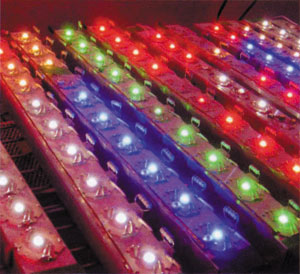
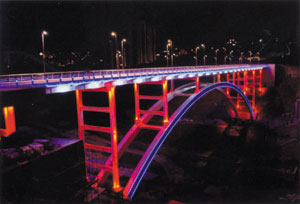
The technology enables Edison Opto to pack 100 1W chips on a 9mm x 9mm ceramic panel to produce 8,000 lumens of brightness.
Tests prove that the high-power packages produce resistance of 5C per watt and show less than 5% illumination degeneration after 1,000 hours of non-stop operation. "Based on the rate, we assume our products will lose 30% illumination after 30,000 to 50,000 hours of non-stop operation depending on product type," Tu analyzes.
Tu reports his company is Taiwan's first LED packager to produce high-power products when it diversified into LED packaging in 2003 from manufacturing of fiber-optical sensor and fiber-optical transition equipment, the company's core business when it was founded in 2001. "Fiber-optical sensors and transition equipment all use LEDs as the major device for beaming signals. When we entered into the LED packaging business, we simply switched our specialization to LEDs used in lighting from LEDs used in signal transmission," he notes.
Edison Opto uses patented high-power chips from heavyweight players like Cree and Bridgelux. Its package designs are also patented. "With patent backing, we could freely ship our products to Europe and North America," says the deputy engineer.
Edison Opto claims to be Taiwan's first LED packager to focus on high-power LED products. "In 2006, our 100W LED project won government funding," Tu says. Now, the company's most efficient packaging can achieve nearly 100 lumens per watt.
The company can provide both commodity packages and built-to-order packages. "One of our tailor-made designs can be seen in the color bin range. We can fine-tune the range to the narrowest, meaning the packages we make can deliver a perfect light in terms of illumination uniformity," Tu says.
Packaging is not the company's only charm. It also designs lens and thermal-dissipation modules for customers. "To do this, you really need know-how on optics, mechanics and electronics," Yu stresses. The company's lens designs perform quite well. Its EdiStar package, for instance, gains 80% more light thanks to the high performance reflection of its lens. "We believe the reflection ratio will increase to 90% when we begin volume production," Tu says.
The company's packages can be used in commercial lights, streetlights, garden lights, and household lights. Europe and North America, mainland China, and Taiwan each account for one third of the company's sales.




